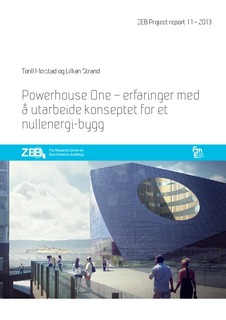| dc.description.abstract | The vision for the building project Powerhouse One is to prove that energy-positive buildings can be built in Norway. The project was initiated by a collaboration called "Powerhouse alliance", which includes the property developer Entra Eiendom, the contractor Skanska, the architect Snøhetta, the environmental NGO ZERO and the aluminium company Hydro, and which was established specifically for that purpose. The development of ambitious criteria that go beyond being "energy-positive" was part of the project. Inter alia it was decided that the quality of energy produced on site shall be similar to the energy used. Moreover, embodied energy in materials and greenhouse gas emissions over the life time of the building shall be compensated for. The planning process included close co-operation with many industrial actors all the way from the start. During a series of workshops, ideas, theories and experiences have been exchanged between participants from a broad range of professions. The nine project participants that were interviewed for this report reported that these workshops, in combination with working in groups, were characterized by a large degree of mutual learning and trust. Above all they underline that integrated solutions could not have been the result without the workshops. Moreover, the participants report to have gained insight into how other professions work. Due to a shared understanding among the partners they expected less work to be required in the next stages of the construction process. To the surprise of some project members, photovoltaics was found to be the most effective among the alternative energy conversion technologies. One of the two major knowledge gaps identified by the interviewees in this context was the integration of energy production into the construction of the building itself. The other challenge was to perform the necessary Life Cycle Assessment (LCA) analysis, as there was a lack of data on energy and raw materials for most construction materials. All project members agree that Powerhouse One will be valuable as a role model project, proving that energy-positive construction is possible in Norway. To reach this goal there are still three major challenges left to be dealt with. The project has to continue to successfully navigate the tension between: • drawing on the best available solutions versus privileging the alliance’s partners’ products • delivering radical innovation versus being a driver of mainstreaming plus-energy buildings, and • integration through collaboration versus efficiency through division of labour. | |
